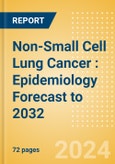1 Non-Small Cell Lung Cancer: Executive Summary
1.1 Catalyst
1.2 Related Reports
1.3 Upcoming Reports
2 Epidemiology
2.1 Disease background
2.2 Risk factors and comorbidities
2.3 Global and historical trends
2.4 8MM forecast methodology
2.4.1 Sources
2.4.2 Forecast assumptions and methods
2.4.3 Forecast assumption and methods: diagnosed incident cases of NSCLC
2.4.4 Forecast assumptions and methods: diagnosed incident cases of NSCLC by stage at diagnosis
2.4.5 Forecast assumptions and methods: diagnosed incident cases of NSCLC by histological type
2.4.6 Forecast assumptions and methods: diagnosed incident cases of non-squamous cell carcinomas and squamous cell carcinomas by immunotherapy biomarker
2.4.7 Forecast assumptions and methods: diagnosed incident cases of non-squamous cell carcinomas and squamous cell carcinomas by genetic biomarkers
2.4.8 Forecast assumptions and methods: diagnosed incident cases of non-squamous cell carcinomas and squamous cell carcinomas by genetic biomarker
2.4.9 Forecast assumptions and methods: diagnosed incident cases of non-squamous cell carcinomas and squamous cell carcinomas by genetic biomarker
2.4.10 Forecast assumptions and methods: five-year diagnosed prevalent cases of NSCLC
2.5 Epidemiological forecast for NSCLC (2022-32)
2.5.1 Diagnosed incident cases of NSCLC
2.5.2 Age-specific diagnosed incident cases of NSCLC
2.5.3 Sex-specific diagnosed incident cases of NSCLC
2.5.4 Diagnosed incident cases of NSCLC by stage
2.5.5 Diagnosed incident cases of NSCLC by histological type
2.5.6 Diagnosed incident cases of NSCLC by immunotherapy biomarker
2.5.7 Diagnosed incident cases of non-squamous and squamous NSCLC by genomic biomarker
2.5.8 Five-year diagnosed prevalent cases of NSCLC
2.6 Discussion
2.6.1 Epidemiological forecast insight
2.6.2 COVID-19 impact
2.6.3 Limitations of the analysis
2.6.4 Strengths of the analysis
3 Appendix
3.1 Bibliography
3.2 About the Authors
3.2.1 Epidemiologist
3.2.2 Reviewers
3.2.3 Vice President of Disease Intelligence and Epidemiology
3.2.4 Global Head of Pharma Research, Analysis and Competitive Intelligence
List of Tables
Table 1: Summary of added and removed data types
Table 2: Summary of updated data types
Table 3: Risk factors and comorbidities for Lung Cancer
Table 4: 8MM, diagnosed incident cases of NSCLC by stage, N, both sexes, ages =18 years, 2022
Table 5: 8MM, diagnosed incident cases of non-squamous and squamous NSCLC by immunotherapy biomarkers, N, both sexes, ages =18 years, 2022
Table 6: 8MM, diagnosed incident cases of non-squamous NSCLC by genomic biomarkers, N, both sexes, ages =18 years, 2022
Table 7: 8MM, diagnosed incident cases of squamous NSCLC by genomic biomarkers, N, both sexes, ages =18 years, 2022
List of Figures
Figure 1: 8MM, diagnosed incident cases of NSCLC, both sexes, N, ages =18 years, 2022 and 2032
Figure 2: 8MM, five-year diagnosed prevalent cases of NSCLC, both sexes, N, ages =18 years, 2022 and 2032
Figure 3: 8MM, diagnosed incidence of NSCLC, men, cases per 100,000 population, ages =18 years, 2012-32
Figure 4: 8MM, diagnosed incidence of NSCLC, women, cases per 100,000 population, ages =18 years, 2012-32
Figure 5: 8MM, sources used to forecast the diagnosed incident cases of NSCLC
Figure 6: 8MM, sources used to forecast the diagnosed incident cases of NSCLC by stage at diagnosis
Figure 7: 8MM, sources used to forecast the diagnosed incident cases of NSCLC by histological type
Figure 8: 8MM, sources used to forecast the diagnosed incident cases of non-squamous cell carcinoma by PDL1, TMB, EGFR, and KRAS mutations
Figure 9: 8MM, sources used to forecast the diagnosed incident cases of non-squamous cell carcinoma by ALK, ROS1, RET, and HER2 mutations.
Figure 10: 8MM, sources used to forecast the diagnosed incident cases of non-squamous cell carcinoma by BRAF, BRAF V600E, NTRK1, and MET Exon 14 mutations.
Figure 11: 8MM, sources used to forecast the diagnosed incident cases of squamous cell carcinomas by PDL1, TMB, EGFR, and KRAS mutations.
Figure 12: 8MM, sources used to forecast the diagnosed incident cases of squamous cell carcinomas by ALK, ROS1, RET, and HER2 mutations.
Figure 13: 8MM, sources used to forecast the five-year diagnosed prevalent cases of NSCLC in the 8MM.
Figure 14: 8MM, diagnosed incident cases of NSCLC, N, both sexes, ages =18 years, 2022
Figure 15: 8MM, diagnosed incident cases of NSCLC by age, N, both sexes, 2022
Figure 16: 8MM, diagnosed incident cases of NSCLC by sex, N, ages =18 years, 2022
Figure 17: 8MM, diagnosed incident cases of NSCLC by histological subtype, N, both sexes, ages =18 years, 2022
Figure 18: 8MM, five-year diagnosed prevalent cases of NSCLC, N, both sexes, =18 years, 2022








